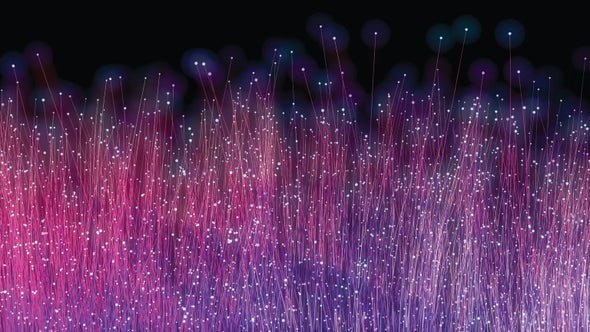Celeste Labedz heard a sound like thunder roll across the ice. She was standing on Alaska’s Taku Glacier, a vast field of snow-smothered ice between towering mountains, when the icequake began: a short-lived seismic tremor caused by the glacier’s sudden movement. Immediately she scrambled for her notebook and jotted down the time. Labedz, a graduate student at the California Institute of Technology, would check that time against data from a fiber-optic cable she and her colleagues had just deployed to study such quakes—a promising new method that is shaking up geology and adjacent fields.
Information travels through a fiber-optic cable via pulses of laser light, most of which moves directly through the hair-thin glass threads. But inevitably a small amount hits microscopic flaws in the cable and scatters back toward the source. This reflection varies when the cable stretches or bends because of ground vibrations, such as those from an earthquake or even a passing truck, and scientists can monitor changes in the backscattered light to quantify those movements. First developed by the petroleum industry a decade ago, this technique—known as distributed acoustic sensing (DAS)—has recently infiltrated the sciences. “The [DAS] community has just exploded in the past couple of years,” says Jonathan Ajo-Franklin, a geophysicist at Rice University. A workshop organized by the American Geophysical Union last December included scientists who had used the technique to image glaciers, monitor thunderstorms and peer into the deep ocean.
One major advantage to DAS is that fiber-optic cables can be many kilometers long, and a single one can act like a network of thousands of sensors covering every meter along its path. Conversely, conventional seismometers record ground motion only at a single point—a major roadblock to imaging the earth’s interior. When Mount St. Helens started rumbling ahead of its catastrophic 1980 eruption, for example, the fact that there was only one nearby seismometer meant that scientists could not tell if the quakes were actually caused by the awakening volcano. “Think of it like streetlights,” says Nathaniel Lindsey, a geophysicist now at Stanford University. “If you only have a few streetlights to illuminate the entire volcano, it’s not going to work that well.”
A second benefit is that fiber-optic cables already crisscross the world. Whereas some sites, such as Taku Glacier, require new cables, others—locations from cities to the bottom of the sea—have unused cables or ones that can be adapted for DAS. Much of this availability stems from the dot-com boom of the 1990s, when telecommunications companies installed long stretches of cables; some of them, known as dark fiber, remain untapped. So scientists can simply connect one end to an “interrogator” unit, which fires a stream of laser pulses toward the other end and monitors any backscatter—and voilà, a new seismic wave–sensing network is ready to go.
Last year Tieyuan Zhu, a geophysicist at Pennsylvania State University, adapted unused cables in the college’s existing fiber network to search for subtle vibrations below campus. He was surprised to find multiple rumbles in his data on the night of a thunderstorm. Although scientists have long known that air vibrations from loud noises can rattle the earth’s surface, it was unclear whether the new technique could detect such “thunderquakes.” But when Zhu synchronized his results with data from NASA, there was no question. “I think there’s a big potential to ‘light up’ the urban area using this technology,” he says. “And not just to monitor earthquakes but also geohazards [such as landslides or tsunamis] and weather.”
Other scientists are eyeing more remote targets. For a paper published last November in Science, Lindsey, Ajo-Franklin and Craig Dawe of the Monterey Bay Aquarium Research Institute attached an interrogator to a 20-kilometer fiber-optic cable typically used to transmit data from scientific instruments on the seabed off Monterey Bay. The system was down for maintenance, giving the scientists a chance to look for vibrations. In just four days they mapped multiple underwater fault zones and characterized seafloor trembling caused by waves above. More detailed seafloor maps will help scientists make better predictions about earthquakes and submarine volcanoes—both of which can cause life-threatening tsunamis.
Then there is the glacier work, for which Labedz and her colleagues have transformed a single cable into 3,000 seismic sensors. Early results show a five-hour stretch with 100 icequakes—many likely caused by meltwater forcing open crevasses within the glacier. Labedz’s academic adviser Zhongwen Zhan, a seismologist at Caltech, hopes to one day place permanent fiber-optic cables in Greenland or Antarctica to help researchers learn more about how glacier melt driven by climate change contributes to sea-level rise.
And Zhan has an even larger dream: to build the equivalent of a million-sensor array in California using about 1,000 kilometers of dark fiber. He has already converted 37 kilometers into a permanent seismic network below Pasadena and would like to do the same in other cities across the state. The data could reveal vulnerabilities in cities’ infrastructure and could help alert citizens the instant an earthquake begins. “This is going to be a huge help in terms of preparing the community,” Zhan says. At the moment, scientists cannot predict earthquakes—but a better understanding of the precursory shocks that occasionally lead up to a main quake could only help.
“Any more data about exactly how earthquakes start and nucleate could be a game changer,” says Robert Mellors, a seismologist at Lawrence Livermore National Laboratory, who was not involved in the research.
But the quantity of data involved also presents a processing problem. DAS easily generates 10 terabytes a day for a single fiber-optic cable; that will add up to a petabyte in just 100 days. In comparison, the international seismological data repository—which collects all the seismological data available across the globe—contains less than a petabyte. Before scientists tap into dark fiber and deploy cables across remote areas, they will first have to learn how to store and share a colossal amount of information.


